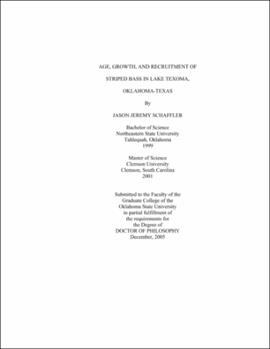| dc.contributor.advisor | Fisher, Bill | |
| dc.contributor.author | Schaffler, Jason Jeremy | |
| dc.date.accessioned | 2013-11-26T08:28:25Z | |
| dc.date.available | 2013-11-26T08:28:25Z | |
| dc.date.issued | 2005-12 | |
| dc.identifier.uri | https://hdl.handle.net/11244/7046 | |
| dc.description.abstract | Scope and Method of Study: Our study was initiated to provide baseline information on the early life history of striped bass Morone saxatilis in Lake Texoma, Oklahoma-Texas. We sampled larval fishes in Lake Texoma using 500 μm mesh plankton nets in the spring of 2002 - 2004. We aged larval and juvenile striped bass to determine growth rates the reproductive period of striped bass. We also evaluated daily mortality rates based on capture data. Striped bass become piscivorous at an early age and stomach content analysis may under represent the true fraction of fish present in their diet. To examine this, we compared predation rates in mesocosms with field data. Because striped bass spawn in the Red and Washita River arms of Lake Texoma, we need to be able to reliable differentiate recruits originating in these two systems. We examined otolith elemental analysis as a means to differentiate these tow stocks of striped bass. | |
| dc.description.abstract | Findings and Conclusions: Striped bass growth and daily instantaneous mortality rates were highly variable. Growth rates ranged from 0.22 - 0.77 mmd-1 and instantaneous daily mortality rates ranged from 0.004 - 0.051 d-1. Growth of larval Morone spp. was negatively influenced by macroplankton density and salinity and positively influenced by river discharge. Mortality of larval Morone spp. was increased by increases in larval fish density, discharge, and microplankton density. Growth rates throughout the larval and juvenile phase were best fit wit a piecewise regression. This was likely due to changes in feeding habits. Temperature was positively correlated and larval fish density was negatively correlated with individual larval and juvenile striped bass growth rates. Results for food availability did not follow any pattern. Stomach content analysis was a good predictor of juvenile striped bass diets. The elemental composition of juvenile striped bass otoliths varied considerably between rivers both within and between years. Overall reclassification rates within each collection year ranged between 73.8% - 97.1%. Reclassification rates between years were much poorer (11.9% - 62.3%). Although the mechanisms generating spatial and temporal differences in otolith chemistry are not well understood, spatial differences in otolith chemistry suggests that the elemental fingerprints of fish from the different natal rivers in Lake Texoma do provide a natural tag of their juvenile habitat. | |
| dc.format | application/pdf | |
| dc.language | en_US | |
| dc.rights | Copyright is held by the author who has granted the Oklahoma State University Library the non-exclusive right to share this material in its institutional repository. Contact Digital Library Services at lib-dls@okstate.edu or 405-744-9161 for the permission policy on the use, reproduction or distribution of this material. | |
| dc.title | Age, growth, and recruitment of striped bass in Lake Texoma, Oklahoma-Texas | |
| dc.contributor.committeeMember | Winkelman, Dana L. | |
| dc.contributor.committeeMember | Echelle, Anthony A. | |
| dc.contributor.committeeMember | Claypool, P. Larry | |
| osu.filename | Schaffler_okstate_0664D_1540 | |
| osu.accesstype | Open Access | |
| dc.type.genre | Dissertation | |
| dc.type.material | Text | |
| thesis.degree.discipline | Integrative Biology | |
| thesis.degree.grantor | Oklahoma State University | |
